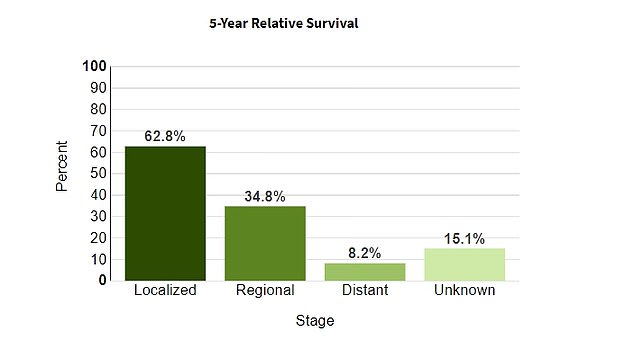I thought I had pulled a muscle, but I had stage 4 lung cancer at age 37, despite never smoking. These are the signs you SHOULD NOT ignore
A Texas woman was diagnosed with stage 4 lung cancer at the age of 37, despite never having smoked.
Tiffany Job, a nurse and mother of eight-year-old twins, assumed the pain in her right rib that started in March 2020 was a pulled muscle resulting from a workout.
However, scans would later reveal tumors in her lungs that had spread to her neck and bones.
“I think I was just in denial, like, ‘This isn’t happening,'” Tiffany said. ‘It was a shock. A big shock.’
Her case comes amid a mysterious increase in cancer cases in people under the age of 40, including colon and appendiceal cancer.
Lung cancer – the deadliest form of the disease – is also on the rise, especially in women. This is believed to be related to the fact that women are slower to quit smoking.
Tiffany Job, 40, was diagnosed with stage four lung cancer after mistaking her symptoms for a pulled muscle

Ms. Jobs’ cancer had spread to her pelvis, right femur and cervical spine
Tiffany’s “strained muscle” quickly became the least of her problems when a collection of other symptoms emerged.
During a hike in July 2020, she could barely walk a few feet without her heart rate spiking and becoming short of breath.
Then, a month later, Tiffany developed a cough that wouldn’t go away. Doctors conducted blood tests and prescribed a course of antibiotics and steroids.
However, nothing helped.
In September, Tiffany went to her doctor, who ordered a pulmonary function test (PFT). This test measures lung volume and capacity, as well as how air moves through it. “I failed miserably there,” she said The patient story.
Her husband, Nick, said: ‘I think they said she had the lung capacity of an 80-year-old.’
‘That caused quite a few concerns. I think that was the first real alarm bell for the GP.’
“Nobody ever speculated that lung cancer might even be an option.”
In the coming weeks, doctors speculated that it could be anything from sarcoidosis – an inflammatory condition caused by an overreaction of the immune system – to Covid and tuberculosis.
Finally, after days in isolation, scans revealed Tiffany had stage four non-small cell lung cancer, which had spread to her pelvis, right thigh and neck.

Ms Job said she was “in denial” after learning about her lung cancer diagnosis, mainly because she had never smoked

Mrs. Job posted on Instagram in November that her primary tumor is growing and her current treatment is ineffective (pictured here with her husband, Nick, and their twin sons)
According to the National Cancer Institute (NCI), lung cancer is the deadliest form of cancer in the US. It is responsible for one in five cancer deaths, followed by colorectal cancer, which causes one in ten cancer deaths.
About 53 percent of cases are diagnosed when the disease has traveled to multiple other organs.
‘The vast majority of lung cancers are diagnosed at an advanced stage because symptoms don’t appear until it progresses quite quickly,’ said Nick.
The survival rate in these cases also drops significantly: less than 10 percent live five years.
Only one in four lung cancer patients survives after five years.
There are two main types of lung cancer: small cell and non-small cell.
Non-small cell lung cancer is the most common type, responsible for nine out of 10 lung cancer diagnoses, and tends to grow more slowly. It usually does not cause symptoms until it has progressed.

According to the National Cancer Institute (NCI), lung cancer is the deadliest form of cancer in the US. The survival rate drops sharply as cancer spreads. Advanced lung cancer has a five-year survival rate of only 8.2 percent

The above shows lung cancer cases among men and women, broken down by age groups. This shows that the disease is now more common in younger women, compared to other groups
According to the NCI, signs of non-small cell lung cancer include chest pain or discomfort, a persistent cough, difficulty breathing, wheezing, coughing up blood, loss of appetite, unintentional weight loss, fatigue or lethargy, difficulty swallowing and swelling. on the face or veins in the neck.
Cigarette smoking is the leading cause of lung cancer, although Tiffany noted that she has never smoked. Exposure to passive smoking has also been shown to increase this risk.
Men were almost twice as likely as women to develop the disease in the 1980s, due to higher rates of smoking and higher workplace exposure to substances such as asbestos.
But with declining cigarette use and increased safety regulations, the pattern has reversed, with young and middle-aged women now more likely to be diagnosed with the disease than men.
There are indications that this is because women quit smoking more slowly.
Tiffany’s tumor had a genetic mutation known as EGFR (epidermal growth factor receptor). This means that the cancer causes an excess of the EGFR protein, which can accelerate the growth of lung cancer cells.
This qualified her for a clinical trial of a drug that would specifically target the mutation.
“The prognosis for lung cancer is quite poor, and chemotherapy does not have a good track record, especially for its cancer subtype,” Nick said.
Tiffany added, “When we heard ‘clinical trials,’ I was very open to it. I think as a nurse I’ve always been quite open to things like that.”
“I feel like that’s how we learn. We don’t get information if people don’t do it.’
However, Tiffany posted on Instagram in November that despite the new therapy, the primary tumor in her lung is growing and her current treatments are no longer effective.
Yet she remains optimistic.
“We don’t know what’s going to happen to us at the end of the day, so we might as well live for every moment,” she said.
